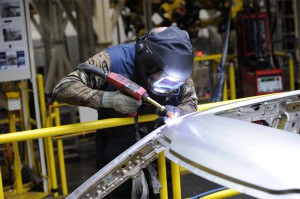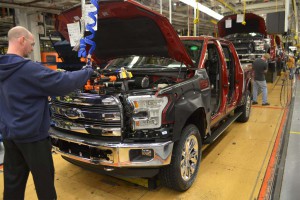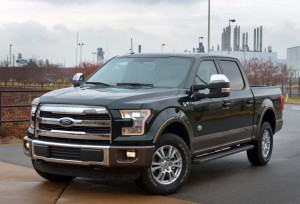It might seem like just another day at the big assembly plant, the full-size F-150 pickups rolling down the line at a steady pace. But a closer look reveals that these aren’t any ordinary trucks; they’re the new aluminum-bodied models that comprise one of the biggest bets Ford Motor Co. has placed in years.
Pressed by both regulators and consumers alike to improve fuel economy, automakers are turning to a variety of solutions, including what the industry likes to call “lightweighting.” And by switching from conventional steel bodies to aluminum, Ford engineers were able to trim as much as 750 pounds of mass from some F-150 models. That is expected to yield significant improvements in mileage when the EPA formally confirms tests on the new truck.
Ford is betting that better mileage and other improvements to the F-150’s design will enhance the appeal of what is already the best-selling vehicle in the U.S. market. Ford produced a total of 647,697 of the trucks last year. Add heavy-duty models such as the F-250 and F-350 and Ford sold about 100,000 more pickups than its nearest competitor, General Motors, in 2013.
It’s always a challenge to keep rolling out a new truck every 49 seconds – the average pace combining the Dearborn Truck Plant and a sister factory near Kansas City, Missouri. Now add an all-new manufacturing system, as Ford had to make major changes to accommodate the F-150’s aluminum body, including the way it stamps and welds sheet metal panels.

A Ford employee welds the roof of the new aluminum-bodied F-150. The maker is starting production on the new truck.
“There’s no question this is a cost hit,” Jeff Schuster, an analyst with LMC Automotive, suggested earlier in the year, while Adam Jonas, an analyst with Morgan Stanley, last month warned that the launch of the new 2015 Ford F-150 may not go “as smoothly as planned.”
That cautious assessment was one of the reasons Ford’s stock price has been in the doldrums in recent weeks.
Few would be surprised if the ramp-up of production is slow. Ford’s new CEO Mark Fields – who will face his first big test with the launch of the aluminum pickup – has stressed that quality, rather than volume, will determine the initial pace of production. But there are other concerns.
The maker says it has adopted military grade alloys for the body of the new truck, claiming the 2015 F-150 will actually be more ding and dent resistant than older ones made of steel. But despite claims that prototypes have undergone at least 10 million miles of testing, it remains to be seen how they will hold up long-term. Durability, reliability and cost of maintenance are three critical factors for many pickup buyers, especially those who use their vehicles for work.
(Ram 1500 EcoDiesel drives off with Green Truck of the Year over F-150. For more, Click Here.)
On the positive side, truck sales have been soaring in recent months, in part because of the upturn of the U.S. economy. The plunge in gas prices, now at their lowest level in at least four years, has also helped. But, ironically, that could hurt Ford, analyst Jonas noted, because fuel costs have slipped on the list of purchase priorities for many truck buyers.
Ford has been toying with the use of aluminum for a number of years. It tested the potential for the lightweight metal with two of its former subsidiaries, Jaguar and Land Rover, before making the move to a mainstream product like the F-150. And it remains confident the switch will pay off in the long run, especially as fuel prices aren’t likely to remain so low for long.
(Click Here for details about why gas prices are expected to remain low.)
“Were we recognizing that it was a risk? Sure,” CEO Fields told the Associated Press. “But it was a very calculated and informed risk that gave us the confidence that we were going to get this done.”
Other analysts back up that assessment, as does a study commissioned by the obviously biased Aluminum Association.
(To see more about Ford’s Farley and Odell swapping jobs, Click Here.)
“Within the next 10 years, seven out of 10 new pickups produced in North America will be aluminum-bodied, and so too will be more than 20% of SUVs and full–sized sedans,” asserted Tom Boney, chairman of the trade association’s Aluminum Transportation Group.
Some pickup buyers have raced to buy the old, steel-bodied F-150, others say they are holding off to see reviews of the new models. Ford, meanwhile, claims it has received requests for more information from more than 224,000 potential buyers of the 2015 truck. And the maker is betting that the traditionally high loyalty rate of pickup owners will work to its advantage.
After conducting countless hours of digital simulations, and millions of miles of prototype assessment on track and highway, the real test will begin next month when the first of the new F-150s reaches U.S. showrooms.



I’ll bet the real world mpg improvement from the ~750 lb. weight reduction doesn’t match what Ford expects due to consumer driving habits.
For some reason I think this is going to turn out to be a 787 with 4 wheels.